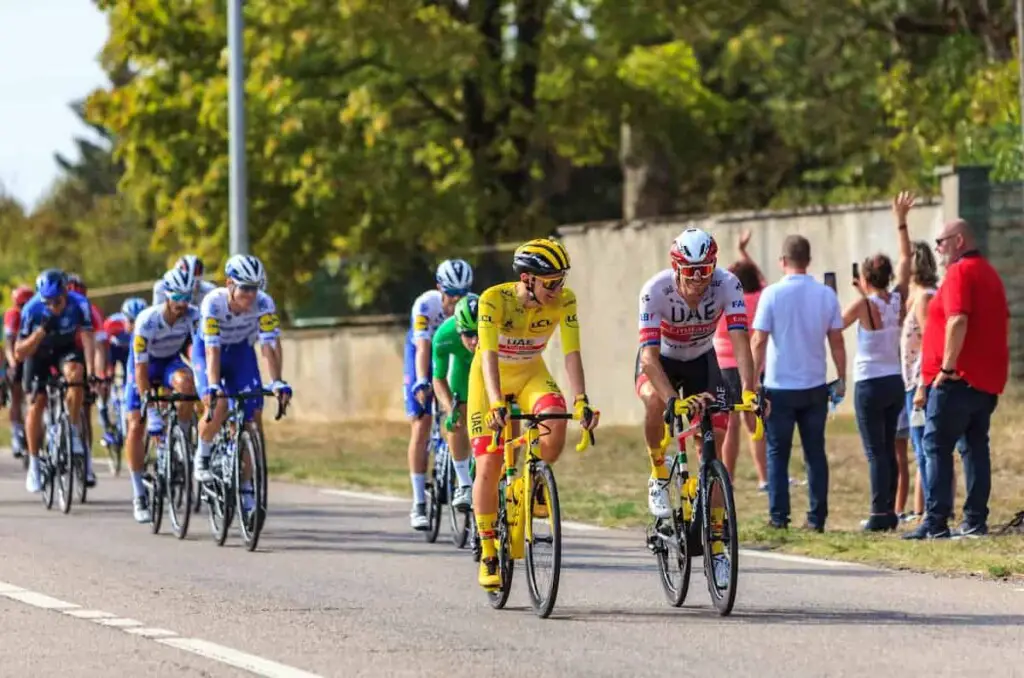Have you ever watched a cycling race and wondered how long you could keep up with the pros? Are they really that much better and produce that much more power?
Professional cyclists have an FTP of around 410 watts, while amateurs record between 250 and 300 watts. However, power is related to weight. Heavier cyclists have higher numbers. Power is therefore looked at in relative terms, with professionals producing around 6 W/kg and amateurs between 3-4 W/kg.
Below we will look at why absolute power is a pretty poor indicator of a cyclist’s ability, why FTP is one of the most important values of a cyclist and what kind of power some professional cyclists achieve.
You can measure your power with a bike computer (less accurate) or with a power meter (more accurate). You can find my bike computer recommendation by clicking here and my power meter recommendation by clicking here.
What is FTP?
Functional threshold power or FTP is a power a cyclist can hold for an hour. It’s the best indicator of a cyclist’s fitness. It also allows comparison between different cyclists.
Power varies greatly between cyclists. Heavier riders will achieve higher power values but will struggle to maintain them for long periods of time. Lighter riders will reach much lower values but will be able to hold them for longer.
FTP allows a clearer comparison between cyclists. But there’s a catch. It’s impossible to compare cyclists’ absolute FTP values, as they are influenced by a number of factors, with weight being the main one.
Absolute power doesn’t matter
It’s nice to have a high FTP value. It gives you bragging rights among fellow cyclists, at least those who don’t know much about how FTP works.
It’s kind of like when we were kids looking through a window of a sports car to see what the number on a speedometer is. Little did we know that the number didn’t really matter.
Heavier cyclists will always record higher power because they have bigger muscles, which together create higher absolute strength. But bigger muscles also weigh more and require more power to move. That makes them inefficient and explains why cyclists want to be as skinny as possible.
Heavier cyclists can produce more power. But bigger muscles also require more power to move.
So how can you compare a lean rider with smaller muscles to a heavier rider with bigger muscles?
The answer is pretty simple – relative power.
Cyclists figured out a long time ago that in order to be efficient, you need to have high relative power. You need to produce as many watts as possible per kilogram of body weight, as that’s the only number that matters.
FTP is, therefore, better seen in relative terms, as it allows us to compare cyclists regardless of their body constitution. In this way, we can compare apples to apples and not apples to oranges, as is the case with absolute values.

How much better are professionals than amateur cyclists?
Now that we have established that relative power allows us to compare any cyclist let’s look at the differences between professionals and amateurs.
It’s no secret that professional cyclists are the best and most trained cyclists in the world. Therefore, amateurs can’t compete with them as even with hours of structured training, we couldn’t come close to them.
The fact is that professional cyclists are not only trained better than amateurs but also possess genetic predispositions that allow them to be that good. I hate to break it to you, but no matter the effort, you will never be able to reach their level.
Below you can see a table showing the relative power of cyclists at different levels. Professionals are categorized as World class and Exceptional, while amateurs can be found in the Moderate to Very Good categories. The last two categories are reserved for untrained casual riders.
| Men (W/kg) | Women (W/kg) | |
|---|---|---|
| World class | Over 5.8 | Over 5.1 |
| Exceptional | 5.2 – 5.8 | 4.6 – 5.1 |
| Excellent | 4.7 – 5.2 | 4.1 – 4.6 |
| Very good | 4.2 – 4.7 | 3.6 – 4.1 |
| Good | 3.6 – 4.2 | 3.1 – 3.6 |
| Moderate | 3.1 – 3.6 | 2.6 – 3.1 |
| Fair | 2.6 – 3.1 | 2.1 – 2.6 |
| Untrained | Under 2.6 | Under 2.1 |
As you can see, professional cyclists are well above trained amateurs. Even cyclists who are more serious about cycling, but are not professionals (excellent group), lag behind the best cyclists in the world by almost 1 W/kg, which is about 20%.
One watt per kilo may not seem like much, but when you multiply it by the total time of the race, the time differences are huge. For instance, if Jonas Vingegaard, winner of the 2022 Tour de France, would average 1 W/kg less than he did, his final time would have been 4 hours and 52 minutes worse. That would have put him in 123rd place out of 134 riders.
What numbers can the average amateur expect?
We must know that ‘amateur cyclists’ is a very broad term. The differences between them are huge, as amateurs include both those who cycle once a week and those who cycle almost every day but do not cycle for a living.
I will try to give you some actual figures for the cyclist who best represents the amateur. So someone who gets on a bike a few times a week and rides between 60 and 100 kilometers (40-60 miles).
If you want to accurate power data, you need to have a power meter. You can check my recommendation for the best power meter by clicking here.
Men amateur cyclists
For our example, we will take a 70 kg (155 lbs) cyclist who cycles three times a week. He’s regularly doing 70+ km (40 mi) rides but can do 100 km (60 mi) without much trouble.
We can expect such a cyclist to have a relative FTP of about 4 W/kg. If we multiply that number by his weight, we get an absolute FTP, which in this case is 280 W.
As an example, I can tell you that my FTP is 279 W, but since I weigh 80 kg (176 lbs), my relative FTP is only 3,5 W/kg. On the other hand, my father has an FTP of 330 W and weighs only 4 kg (9 lbs) more. So his relative FTP is 3,9 W/kg.
He spends more time on a bike and is more trained than I am. Therefore his numbers are higher. Our two examples, therefore, confirm that amateurs will have a relative FTP between 3 and 4 W/kg.
Female amateur cyclists
Let’s also analyze female cyclists. This time we’ll take a 60 kg (132 lbs) cyclist who also does three longer rides per week.
Women tend to have lower FTP than men. So we can expect a female amateur to have a relative FTP of about 3,5 W/kg. Converted to an absolute number, that means an FTP of 210 W.
Actual power data of professional cyclists
I’m sure you want to know the exact power numbers of some of the world’s best cyclists. Good news – you can find them here!
Below is a table with data on the power of male professional cyclists, courtesy of ProCyclink UK.
Notice how heavier riders have higher absolute FTP but are far behind lighter riders regarding relative FTP. One of the lightest riders – Egan Bernal – has the highest relative FTP but has one of the lowest absolute FTP. He will never win a sprint, but he sure can be fast over the climbs.
Power data of male professional cyclists
| Name | FTP (W) | Weight (kg) | W/kg |
|---|---|---|---|
| Wout van Aert | 460 | 78 | 5.90 |
| Florian Vermeersch | 460 | 82 | 5.61 |
| Mathieu van der Poel | 454 | 75 | 6.05 |
| Ben Swift | 430 | 70 | 6.14 |
| Alexander Kristoff | 430 | 81 | 5.31 |
| Tadej Pogačar | 424 | 66 | 6.42 |
| Michal Kwiatkowski | 420 | 68 | 6.18 |
| Neilson Powless | 400 | 66 | 6.06 |
| Tim Declercq | 400 | 78 | 5.13 |
| Ben O’Connor | 395 | 67 | 5.91 |
| Victor Campenaerts | 394 | 69 | 5.71 |
| Michael Matthews | 393 | 70 | 5.61 |
| Egan Bernal | 383 | 59 | 6.50 |
| Sepp Kuss | 383 | 61 | 6.28 |
| George Bennett | 350 | 58 | 6.03 |
Below you can also find actual numbers of professional female cyclists. For them, a relative FTP over 6 W/kg is unreachable (for now), but some can reach the 5.5 W/kg range.
In a professional caravan, there is one rider that I believe could potentially reach 6 W/kg. That’s Annemiek van Vleuten, but unfortunately, she doesn’t care about power data, so we don’t have any. She also said a couple of times she doesn’t know what her FTP is.
Power data of female professional cyclists
| Name | FTP (W) | Weight (kg) | W/kg |
|---|---|---|---|
| Ilaria Sanguineti | 340 | 61 | 5.57 |
| Kristen Faulkner | 323 | 62 | 5.21 |
| Chloé Dygert | 316 | 66 | 4.79 |
| Lizzy Banks | 311 | 62 | 5.02 |
| Evelyn Stevens | 305 | 55 | 5.55 |
| Eugenia Bujak | 298 | 61 | 4.89 |
| Anna Henderson | 285 | 58 | 4.91 |
| Liane Lippert | 278 | 55 | 5.05 |
| Lucinda Brand | 276 | 58 | 4.76 |
| Lisa Brennauer | 274 | 65 | 4.22 |
| Ashleigh Moolman-Pasio | 264 | 49 | 5.39 |
| Elisa Balsamo | 261 | 58 | 4.50 |
| Urška Žigart | 235 | 49 | 4.80 |
| Puck Moonen | 229 | 56 | 4.09 |
| Coryn Rivera | 204 | 48 | 4.25 |
Conclusion
Power data is always interesting to look at, both for amateur and professional cyclists. Amateurs may even be more obsessed with it, as professionals can judge their form by feeling.
Amateurs want to constantly compare themselves to the pros, but the fact is that when it comes to power, the differences are huge. Professionals regularly achieve values between 5 and 6 W/kg that amateurs can only dream of.
Well-trained amateurs, who spend a lot of time cycling and follow structured training, can reach 5 W/kg. Others, who just ride longer distances without any real training in mind, can only reach values between 3 and 4 W/kg.
Converting relative power into absolute power makes no particular sense. It is nice to look at the big number you achieve, but it tells you very little. It allows you to compare yourself with yourself, but not with other cyclists.
Absolute power is influenced by many factors, especially weight. Heavier cyclists will always have higher absolute power, while lighter cyclists generally have higher relative power.
In the end, let me just give you this advice. Don’t get too hung up on the data on your bike computer. Cycling is primarily about enjoyment, so look up from the screen and enjoy the nature around you.


